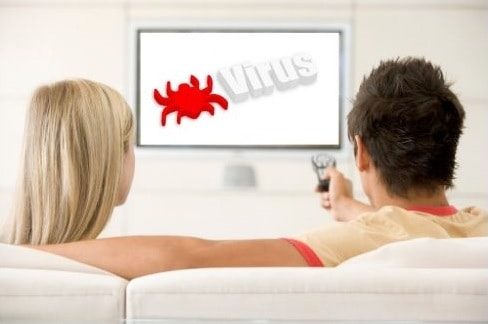No matter if you are a high-end gamer, an avid Netflix lover or someone who just streams their favourite TV shows; Smart TV is a common household thing now. And frankly, thanks to the globalisation and the way technology around televisions has been upgraded and advanced; these smart equipment’s and gadgets are currently available at our disposal for a low price. It is not just for the affluent and everyone and anyone could get their hands on a smart TV without shelling out boatloads of money.
The question at hand is, Can smart televisions get a virus? Unfortunately, “YES”. Smart TV’s are prone to get attacked by a virus and also hacked at the same time. You weren’t expecting this now, were you? In all honesty, there are a couple of reasons why I have concluded to this answer, and after careful research, I thought to myself, let us compose an article on this topic and share it with my valuable readers here at SmartNutter.com
Without a doubt in mind, Smart TV’s are an integral part of any household. Let it be a smart home or not, this is the first thing that every new or an existing homeowner should own. And quite surprisingly, many of the homeowners that I know of having got Smart TV’s at home and are using it purely as a regular TV. Just because the technology has revolutionised this industry so well, that almost all the TV’s that you pick up from your favourite retailer these days are equipped with Smart functions. Also the fact, that smart TV’s offer a ton of content that was otherwise not possible to access without you drawing out your laptop and hooking it up to your old TV’s via HDMI cables or the infamous VGA cables. You must be thinking what was wrong in that? Well, a couple of things
The prime difference in old TV’s and Smart TV’s
| Old TV | Smart TV |
| Used a simple screen to project what was connected to it via the RF port, HDMI port and/or VGA ports. | Capable of broadcasting anything you deem fit via your smartphones, laptops, etc. both via HDMI cables and even remotely using apps. |
| No built-in Internet facility | Has an integrated Internet facility |
| No built-in web browsers | Has built-in web browsers |
| No built-in apps | Has a plethora of built-in apps |
| No streaming capabilities | Has streaming capabilities |
| No touchscreen option | May have a touchscreen option, depending on which model you choose |
| Bulkier | Slim and Eloquent |
So now, having said that; with all these latest features and gigs that come in the latest Smart TV’s, what exactly is it that one can do to protect them from viruses. And should you really be worried about it? Let us understand this article from a logical perspective.
Table of Contents
What Actually Caused the Concern for Scanning Your Smart TV for Viruses?

Well, it all started off by a tweet from Samsung. They started off by saying that
Scanning your computer for viruses is important to keep it running smoothly. This is also true for your QLED TV if it’s connected to the Wi-Fi!
This was mentioned on the @SamsungSupport twitter channel. But was eventually deleted as soon as it caught the wrong hype.
This sparked a great deal of conversation over the internet, and almost all those who owned a Smart TV at home were triggered by it. Hey, who wants to believe that their Smart TV’s could be hacked or get hold of a virus and then eventually stop working? No one!
Let us assume that since Samsung claimed that it is especially important for their QLED range of smart TV’s to run an Antivirus scan every once in a while, does it stop from other series of Smart TV’s that are out there in the market today, to not follow the same routine as well? After all, Samsung uses Tizen Operating system and it would be very much safe to assume that all the Smart TV’s that are running this Operating System are vulnerable to a virus attack. We all know how the internet is and how a piece of news spreads like a fire in the forest. So was the case with this particular Tweet from an authoritative website such as Samsung.
We would never know if it was a marketing stunt, or whatever it was; it certainly did raise an alarm amongst the Smart TV owners and there was a layer of uncertainty prevailed whether our particular model of the smart TV to is hacked or not.
Fundamentals of the Operating Systems Present in Smart TV’s
I will be taking into the equation only the top 3 manufacturers in the smart TV’s line for this particular article. According to eMarketer, almost 46 million US households have got access to Smart TVs. That marks an increase of 16% of the total number of Smart TV owners back in 2017. Based on research conducted, it was reported that approximately 37.2% of the household have got a Smart TV’s at their homes.
Those top 3 manufacturers are
- LG
- Panasonic
- Samsung
According to Forbes, they have compiled a list of 5 Best Smart TV’s manufactured in 2019 and have given their recommendation based on a 2 year-study done on the features of these product lineups. You can’t go wrong with the advice that Forbes makes now, can you?
Now, let us get straight to the topic!
All those Televisions which have got the Android operating systems installed in it should know that an Android platform is considered as an Open-Source platform. Which means that these smart TV’s are equipped with Google’s PlayStore, thus giving you “the owner” the privilege to download whatever they want from Google’s PlayStore. This in return, opens up the Pandora’s Box. I will tell you why!
All of the manufacturers that aren’t using Android as their Smart TV’s OS are referred to as a closed-OS. Which means that any app that you want to download into your smart TV is only available via their dedicated content stores present. These apps are carefully vetted and provide limited to no access to the root of the OS present on such models. So the chances of getting malware or a virus through these apps are close to none. But in the Android versions, the manufacturer has zero to no control over what you download into the Smart TV and thus the chances of getting a compromised TV are high. But in all honesty, do we find stories of people’s television getting bricked or hacked every day? The chances are it’s close to none.
One wrong download from the Google’s PlayStore into your smart TV can basically open up loopholes into the gadget that renders the TV’s security useless and thus allowing the hacker to gain control over not only the television but also your router. And once that happens, all hell breaks loose and you can only imagine what could then go wrong in your smart home environment. If you are really persistent and keen that you can’t live away from customizing your smart TV using the Google’s PlayStore, then I strongly recommend you go through my article on how to protect your IoT infrastructure at home by exercising the tips to protect your smart devices from both hackers and malware.
Security Features That Smart TV Manufacturers Exercise For Optimum Safety

All the smart TV manufacturers strive to create the most secure platform than their competitors. Since they can’t afford to have, their TV’s becoming hacked and eventually the negative marketing would severely impact their future sales and reputation. Hence the baseline framework that these manufacturers follow is to lock their platforms for “Read-Only” mode. Which means that the TV’s OS can only read the data from the board, and no option is available for it to “Write” on the memory blocks.
Therefore if anyone is to hack the Smart TV’s, then the hacker would be required to reverse-engineer the code and thus to force the motherboard to “Read & Write”. Which is easier said than done, to be honest. Coming from an IT background myself, this is virtually impossible since the motherboards are so very complicated that it is not possible to do it. But that being said, there are still ways to go around it which I would not be discussing in this article since this isn’t an article based around my University’s textbooks. *rolling on the floor, laughing*
Another countermeasure that the Smart TV manufacturers are accustomed to following the is by deploying and using “Digital Signatures”. I do not want to overcomplicate this one for you. Still, a digital signature is when a new update is pushed to your smart television OTA (over the air), it basically overwrites the previous firmware and overwrites it with the new one. So in the event, a virus was indeed present in your firmware, it would just be wiped away and deleted when the new firmware gets pushed in. Which is also a part of the solution if your TV gets compromised. More of it later down in the article!
What Other Ways Can a Virus Enter Into Your Smart TV?
Well, other than running dubious apps downloaded from the Google’s PlayStore directly into your telly, it is very much possible that you can compromise your smart TV by the use of USB drives that you insert into the television to play whatever is present onto them. These USB’s might have a pool of Trojans or viruses that are capable to mess around with the Smart TV’s configurations and settings, thus allowing it to get hacked or attacked by a virus.
There are a couple of stories that are available on the internet that I clubbed together here in this article for your reading pleasure.
USAToday Article on Smart TV’s Being Hacked
In an article published on USAToday, the FBI has also warned the masses to remain vigilant when using their Smart TV’s.
FBI has asked the people to exercise caution during the Black Friday shopping Spree. Since this is coming directly from the horse’s mouth, this should be significantly practised too.
I at SmartNutter.com strongly urge people to stay away from downloading and using unwanted apps from Google’s PlayStore onto your Smart TV’s. Always use the apps that are carefully vetted and have got a high trust score. You never know, if a hacker is watching you from your telly’s microphone and camera. Woah! Scary.
Story of a User Who Infected His Own Android Smart TV
A user named “Candid Wueest” at the Symantec’s Official Blog reportedly installed ransomware in his own Android-based smart TV. After carefully administering the virus into his TV, he was successfully able to lock himself out from his telly. He tried approaching the TV”s manufacturer for an obvious solution into getting hold of his TV’s original state but was not successful. Eventually, since this was a careful experiment by him to prove that Smart TV’s can be hacked, he had enabled the Android’s ADB Debugging option initially and thus was able to restore his smart TV into his original state by using the ADB shell.
Which I believe is something that you and others would not be able to do. So I strongly recommend and suggest to stay away from the unwanted apps that are lurking around the web. Just stick to the well-renowned streaming apps that come along with your smart Television. Do not go about customising it using unethical methods, because you never know; you might end up with an expensive paperweight of a TV which has no other purpose then once it gets compromised.
Story of a Hacked Smart TV on the Christmas Day
Back in 2017, a software engineer named “Darren Cauthon” reported that his LG smart TV got infected with ransomware and the perpetrator wanted $500 in ransom to unlock his smart telly.
You must be thinking that I had claimed above in the article that LG uses a closed-platform then how was this possible. Well until 2014, LG was running the Google TV platform in their smart TV’s which later got replaced by the famous LG’s WebOS. This ransomware struck Google TV’s platform version.
Darren contacted the LG support and was advised to bring his television set to the LG’s service centre who would then charge him with a $340 for the assistance of removing the ransomware.
Given the $500 demand from the attacker and the $340 bill imposed by the LG’s service centre, Darren was able to reset his TV using the hidden reset settings given by LG. Happy ending!
The ransomware screen showed the following message which can easily be seen in the video linked below
What Can You Do If Your Smart TV Does Get Infected By a Virus?
So having said all that, let us now assume that your smart TV does get infected by a virus. What are the steps that you should take to remove it from your particular set are listed below? Go through them wisely.
1. Force Scan Your TV and other Peripherals that are Attached Do It
Almost all of the modern smart TV’s are equipped with built-in antivirus systems to ward off from the evil. I said that right!
Do bear in mind that if you expect the performance of these built-in smart TV’s antivirus systems to act per an antivirus that is present in your smartphones and laptops, then you sir are wrong! The most significant downside of the smart TV’s antivirus systems could be that they are incapable of performing an auto-scan or scheduled scans on your TV and the peripherals. So it is entirely at the discretion of the owner that they run the scans manually from time to time. Just what the great Samsung said in their invisible tweet! *banter*
Just get hold of the user’s manual that came along with your TV. Let us also assume that you were like me and were quiet in haste to fire up the new smart TV that you just bought, and chucked away the box along with the user manual; then I’d find this website very handy where I can get all the manuals of almost any smart product that I own. Yes, it is categorically true that I had thrown away all of the user manual’s that came along with my gadgets. My wife wasn’t too pleased with this either, Ouchy!
2. Restoring your Smart Television to Factory Settings
In case of what happened with Darren Cauthon, all you need to do is to get in touch with your manufacturer through their support page and share with them all the images of what your TV is displaying when it gets attacked by a virus.
They should inherently be able to provide you with the necessary instructions on how to reset your smart TV to its factory settings, thus obliterating the virus.
3. Do Not Press “REMIND ME LATER” on Software Updates
Stop doing that people! It is you inviting mischief to play its role and wreck your gadget if you are accustomed like my mom to press the “REMIND ME LATER” button for months.
All of the Smart Televisions come equipped with an Auto-Update feature. Make sure that is enabled in under the Settings Page of your particular brand. If that is not on (which I find it difficult to digest); then make sure to check for updates every once in a while.
You can quickly lose track of updating your apps present on the telly as well. So apart from the system updates that your manufacturer wants you to perform on the television, it is best advised to also enable the auto-update feature on these app stores present on your particular make just in order to ensure that all the latest updates are done.
Latest updates not always, but do tend to; resort to the security fixes and patches that the developers have found as loopholes in their firmware.
4. Prefer Wired Connections over Wireless
Always prefer connecting your Smart TV to your Wi-Fi router via the CAT-5e or the CAT-6 cable.
Wired connections are complicated for hackers to gain access to. You can also invest in a secure VPN application to further secure your smart home connectivity.
5. Steer Clear from Shady TV Manufactures
Do not fall prey to giveaways, offers, BOGOFF (Buy-one-Get-one-Free) offers when it comes down to your smart home gadgets. Especially smart Television. Inexpensive versions of the smart TV’s lack the proper support that is there with reputable manufacturers such as LG, Samsung, Panasonic and Sharp.
So, say NO to LGe, Panasyonic, Saimsung. Hail!
6. Do Not Connect Infected USB Devices into Your Smart TV
A general rule of thumb is if you have an infected USB drive; then first connect it to your laptop or desktop computer and run a thorough scan on it. If the antivirus is not able to remove the infection from the USB drive, then chances are it is infected with a more advanced threat and the only way out is to format it. If you believe, the data present on your drive is valuable and you can’t part your ways with it. My best advice is to keep the drive aside and wait for the updates on your antivirus hoping that the antivirus you are using does get the DAT engine files to its core inclusions.
Tips To Avoid Ending Up With a Hacked Smart TV

Although not common, also not impossible; I am yet to see a hoard of people complaining that their smart TV’s got struck by ransomware or a virus. But still, prevention is always better than cure I always say. As smart TV’s gain popularity, I am confident that more and more hackers would now start focusing on this particular gadget to gain control over our sensitive data. So please, follow the following tips and suggestions to ensure you are hack-safe!
- As soon as you fire up your brand new Smart TV, make sure you read the Privacy Policy page and not just steam-roll through it. You need to ascertain what kind of information is being shared and what you are agreeing on to.
- If you have got a smart TV that has an Android OS inbuilt, then avoid downloading cracked software’s.
- Make sure that you have enabled the “APP VERIFICATION”.
- If your smart TV has come with a built-in camera and a microphone, make sure that you have disabled them once you are not using these features.
- If you are buying a used Smart TV from Craigslist or eBay, then ensure that you communicate with the seller and have it in black white that the smart TV has not been tampered with and/or opened.
- If the smart TV that you are about to buy is not from a reputable manufacturer, then ensure you communicate with their support and enquire about the frequency of them updating the firmware’s and providing security patches to their product. If the updates aren’t timely, please pass on that particular purchase.
- Enable Automatic Updates and do not miss out on any updates alerted by the manufacturer of your particular model.
Related Questions
I have covered some additional topics on this article that I am sure my blog followers will be having in their mind after going through the above information.
So here we are.
Can WebOS be hacked?
Yes, but you would need to get your hands dirty on a plethora of tools and hardware before you can actually do that. Bear in mind, that once you reverse engineer the LG’s flagship webOS; you are voiding the warranty and any possible lawsuit from LG as well. So stay away from breaking into the webOS or in fact; any other OS.
Can you root a WebOS LG tv?
The straight forward answer is, “Yes”.
To root the webOS of the LG TV, you need to create a developer account on the LG’s Developer website.
It also involves using a complicated set of applications which then allow you to access the main core files that are running your smart TV. Once you have gained root access to your television, then the sky is the limit. You can even overclock your TV’s processors and whatnot.
Can Android OS on Smart TV’s be hacked?
Weren’t you reading this article? God! The whole article revolves around how easy it is to have a compromised Smart TV running the Android OS. Ensure that you follow the best practices as outlined in this article to avoid getting hacked.
Does Android TV need Antivirus?
My personal opinion on this particular question at hand is “YES”. You certainly need a well-reputed Antivirus to back your Android-based Smart TV since it is an open-source platform and chances of getting a hacked device are more.
Can Roku Get a Virus?
To be honest, if you stick to the official ROKU’s channel lists; then you should be fine. Since these are carefully vetted by ROKU. But if you wander away in the dark and access channels which otherwise are not vetted, then you sir are on your own. Tread with caution!
Can You Get a Virus from Netflix?
You most certainly can get infected with a virus from Netflix. But so is the case with any other reputable site. No one can give you a guarantee that their website is hack-proof. Still, the chances of Netflix being hacked and transmitting viruses are close to zero as the company itself has employed highly trained security professionals and programmers to take care of this task.
Conclusion
All in all, it is very much possible that your smart TV could be hacked, attacked by a virus, or even bricked via ransomware. If you were reading through till the end of this article, you must know by now the number of steps and measures that you can take to mitigate such attacks and keep your precious smart TV investment safe from the prying eyes and attackers.
Bottom line is, keep your smart TV’s firmware updated at all times. Ensure that the apps you have installed into your Smart TV also have got the auto-update enabled. If that is not the case in your particular TV make, then ensure to update everything manually from time to time.
Happy Jetson’s Smart Tv’ing people! *wink*



